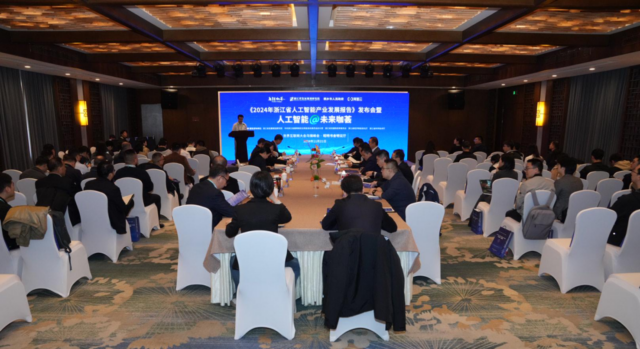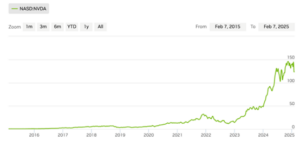
DeepSeek’s Background Raises Multiple Concerns
Publication: China Brief Volume: 25 Issue: 3
By:

Executive Summary:
- DeepSeek and its parent company, High-Flyer, are embedded in the vibrant—and heavily state-subsidized—“Hangzhou Chengxi Science and Technology Innovation Corridor,” which aims to create a Chinese answer to Silicon Valley in the companies’ hometown.
- DeepSeek claims that its models are not trained on GPUs illegally imported to the People’s Republic of China (PRC), but data indicates that PRC firms could be acquiring banned chips rerouted via Singapore, though Singapore denies this.
- DeepSeek’s operational code is open source, but it has released no training code, making it impossible to verify the hardware used to train its latest model.
- Evidence of the app sending data packets back to the PRC and to PRC-owned servers, despite claims by DeepSeek to the contrary, adds to growing security concerns about the company and its products, as does the models’ censorship of topics sensitive to the Chinese Communist Party.
The release on January 20 of DeepSeek-R1, the latest large language model (LLM) from artificial intelligence (AI) firm DeepSeek, sent a shudder through the U.S. stock market. Overnight, about a trillion dollars evaporated from some of the world’s most successful tech firms. Meanwhile, its app rapidly became the most downloaded app on Apple’s App Store. The company, headquartered in Hangzhou, claimed that the model was trained at a markedly lower cost than Western competitors (DeepSeek, January 20; Github, January 23; Business Insider, January 26). DeepSeek’s functionality is impressive, and its name-brand recognition has far eclipsed its parent company, an under-the-radar hedge fund that has long focused on AI and machine learning (China Brief Notes, February 11).
Export Controls and GPU Smuggling Have Accompanied DeepSeek’s Rise
The LLM chatbot known as “DeepSeek” was developed by Hangzhou DeepSeek Artificial Intelligence Basic Technology Research (杭州深度求索人工智能基础技术研究). A 2023 spinoff of the Chinese quantitative hedge fund Ningbo High-Flyer Quantitative Investment Management Partnership (宁波幻方量化投资管理合伙企业), or “High-Flyer,” DeepSeek was initially billed as a “new, independent research body” focused purely on AI research rather than trading or market analysis (Yicai, April 17, 2023). It claims that training costs for its V3 model (on which R1 is based) were a mere $6 million, a fraction of the estimated costs of OpenAI’s GPT-4, which amounted to $100 million in 2023 (arXiv, December 1, 2023; December 26, 2024). Following the release of DeepSeek-R1, fears that it heralded the end of the “AI bubble” led to the U.S. stock market shedding more than $1 trillion. NVIDIA—the company whose advanced and expensive graphics processing unit (GPU) designs are vital for training and running LLMs, allowing it to benefit the most from the AI surge in the last two years—experienced its biggest one-day sell-off in history. This selloff was largely believed to be predicated on the assumption that DeepSeek’s technical achievements would signal lower demand for NVIDIA’s products (Datacenter Dynamics, January 28).
Figure 1: NVIDIA Share Price, February 7, 2015–February 7, 2025

(Source: NVIDIA, accessed February 11)
N.B. The sharp drop at the end of the graph after the launch of DeepSeek’s R1 model.
DeepSeek’s model is open source, allowing anyone to run it on their own hardware, but the details of its development—that is to say, its training data, processes, and the code used in training—remain opaque. While the company has made parts of their codebase open source, the data related to DeepSeek-V3’s deployment and inference functions, the training processes, and code for training the model have not been released as of February 13. Likewise, there is no way to independently verify the company’s claims that it sourced the necessary GPU hardware to train the model through legal channels (Huggingface, accessed February 13).
Reports indicate that the company spent several years stockpiling chips. In a 2020 interview with investment blogger Zhu Ang (朱昂), High-Flyer co-founder and CEO Lu Zhengzhe (陆政哲) claimed that High-Flyer already had invested RMB 100 million ($13.8 million) in “pure hardware (纯硬件)” (Sina Finance, June 10, 2020). [1] More recently, DeepSeek stated that Liang Wenfeng (梁文锋)—the public face and co-founder of both High-Flyer and DeepSeek—spent years buying advanced GPUs as a hobbyist prior to the imposition of U.S. sanctions in October 2022. The company insists that it did not use any U.S. export-controlled GPUs which may have been illegally imported to the People’s Republic of China (PRC) (Wired, January 25).
Yet for many companies like DeepSeek, questions about the use of U.S. export-controlled chips making their way to the PRC through third-party countries remain. Shipments of NVIDIA chips to Singapore have increased since U.S. export controls blocked PRC access. Smuggling and diverting products away from their stated destination have also increased (Wall Street Journal, July 2, 2024; China Brief, December 6, 2024). NVIDIA’s quarterly financial statement for the period ending October 27, 2024, explicitly notes these new sales to Singaporean entities, stating that “most shipments associated with Singapore revenue were to locations other than Singapore and shipments to Singapore were insignificant.” NVIDIA sales to customers with billing addresses in Singapore cause revenue associated with the country to jump from approximately $10 billion in 2023 to $17.4 billion in 2024 (SEC, November 20, 2024).
Figure 2: NVIDIA Revenue by Geographic Area, Q3 2024

(Source: NVIDIA, accessed February 11)
Singapore’s Ministry of Trade and Industry released a statement on February 1 addressing rumors that the small country was being used to reroute controlled items to the PRC. The ministry restated NVIDIA’s assertion that they had no reason to believe shipments to Singapore ended up at DeepSeek or in the PRC, quoting the aforementioned quarterly financial statement and stressing that many of the business entities in Singapore are purchasing the chips “for products destined for the U.S. and other Western countries” (Ministry of Trade and Industry, February 1).
Liang’s Mentor Researched Dual-Use Technologies
Liang Wenfeng was an early proponent and adopter of AI. Before founding the firms he continues to oversee, he spent years developing algorithmic trading strategies with friends he met at Zhejiang University (浙江大学). His colleague Lu Zhengzhe (陆政哲) has described the nucleus of students who went on to build High-Flyer as friends from the university’s computer science and engineering programs. Lu said that they were united by a “systematic and programmatic approach to studying the market (系统化和程序化的方式来研究市场),” collaborating and competing in the years 2008–2015 before establishing the company. After its founding, the company grew quickly and by 2020 was “absorbing expert AI talent on a large scale (大规模吸纳 AI 专家型人才)” (Sina Finance, June 10, 2020).
At Zhejiang University, Liang appears to have first studied AI under Xiang Zhiyu (项志宇), a prominent AI and machine learning expert. Xiang has published dozens of papers and holds many patents, almost all of which are in the fields of autonomous vehicle navigation and AI image processing. Xiang’s extensive body of work includes at least one published collaboration with Liang while the DeepSeek founder studied under him at Zhejiang University (Zhejiang University, accessed February 11). It appears the earliest collaboration between the two is a 2011 paper on an algorithm designed to improve camera target-tracking, a topic that closely matches Xiang’s specialization on autonomous vehicle navigation, mapping, and targeting systems (Aminer, 2011). [2] An analysis of Xiang’s patents and papers published since 2010 finds that nearly all are related to AI, especially autonomous vehicle navigation and image data processing (Aminer, accessed February 11).
Among Xiang’s work, multiple papers and patents cover military use-case applications. Most of his work covers civilian-use technologies such as those suited for the operation of vehicles in predictable urban traffic (autonomous vehicle navigation systems, stop-light recognition tools, LiDar mapping, pedestrian-detection systems, and the like). Xiang has written papers and holds patents on algorithms for cooperative drone swarms, ground-target acquisition systems for UAVs, and the operation of autonomous vehicles in battlespaces with unpredictable terrain: densely vegetated and off-road environments, and environments where an adversary has denied or disabled access to traditional GPS navigational tools. [3]
DeepSeek Embedded in Regional AI Ecosystem
DeepSeek and High-Flyer are based in Hangzhou, which is also in Zhejiang. Besides Liang and Lu’s connection to the provincial university, this is no accident. The Hangzhou’s Chengxi Science and Technology Innovation Corridor (城西科创大走廊), a project under the auspices of local and national government, aims to transform the city into a hub for strategic technology, especially AI. The Five-Year Plan for the Development of Hangzhou’s Artificial Intelligence Industry, announced in December 2021, explicitly states the need to develop and cultivate private AI enterprises located in the city, guided by “the spirit of Xi Jinping Though on Socialism with Chinese Characteristics,” and to establish Hangzhou as the PRC’s answer to Silicon Valley—referred to as “China’s Vision Valley (中国视谷)”—where “a new generation of AI innovation and development” can take place (Hangzhou Municipal Bureau of Economy and Informatization, December 23, 2021).
Hangzhou’s Zhejiang Lab (之江实验室), [4] a mixed-ownership institution organized by the Zhejiang Provincial government, Zhejiang University, and Alibaba Group, serves as a nexus for sensitive technology research. It is also a state-backed organizer, funder, and recruiting facilitator for independent development in AI and other high technology fields in Zhejiang (Zhejiang Human Resources and Social Security Department). At its founding in 2017, the PRC’s Ministry of Science and Technology (MOST; 科学技术部) defined Zhejiang Lab as the “core soul (核心灵魂)” of the construction of Hangzhou Chengxi Science and Technology Innovation Corridor (MOST, September 12, 2017). As one of the country’s largest and most prestigious AI laboratories, it is focused on strategic priorities, describing its aim as to build “national strategic scientific and technological capabilities (打造国家战略科技力量).” Besides conducting its own research projects, Zhejiang Lab frequently hosts recruiting events to attract talented ethnic Chinese STEM graduates educated overseas to the Hangzhou region (Zhejiang Lab, February 2). This constitutes another important sense in which DeepSeek is deeply woven into the country’s national AI ecosystem (China Brief Notes, February 11).
Figure 3: DeepSeek Censors Sensitive Responses


(Source: Screenshots of DeepSeek chat window, February 7)
This situation contributes to concerns raised by lawmakers and regulators outside of the PRC over both data privacy and censorship. Some, including the United States, Taiwan, India, South Korea, Australia, and Italy, have already imposed bans or blocks of various kinds on the app (IndiaTV, February 6). These concerns appear well-founded. According to analysis by cybersecurity researcher David Bombal, the DeepSeek app sends data packets to servers in the PRC and the United Kingdom. Those servers appear to belong to Shenzhen Tencent Computer Systems (深圳市腾讯计算机系统) in Beijing and Zhejiang Taobao Network (浙江淘宝网络) in London. The latter is a Zhejiang-based subcontractor for Alibaba and Alibaba Cloud. This contradicts DeepSeek’s claim that no user data is sent back to the PRC (NDTV, February 5).
DeepSeek also censors responses, including those deemed politically sensitive by the Chinese Communist Party, when run on-cloud (as opposed to locally, on a device not connected to the Internet). [5] For example, it will self-censor responses in real-time on topics such as those related to the 1989 Tiananmen Square protests and massacre. This is shown in the two snapshots in Figure 3 above.
Conclusion
DeepSeek continues to gain traction both within the PRC and overseas for its impressive LLMs. However, key parts of the company’s background and the story behind its remarkable products remain unclear. This has prompted lawmakers in several countries to proceed with caution. While markets may have overreacted upon the R1 model’s release in late January, the viability of DeepSeek as a true competitor to Western LLMs remains to be seen, particularly as the company now will come under increasing pressure from home and ever more scrutiny from overseas.
Notes
[1] NVIDIA’s A100 GPUs cost roughly $10,000 per unit, while its most advanced, the H100, costs $35,000–$40,000 per unit. These prices can fluctuate wildly according to market demand, however (NVIDIA, May 14, 2020).
[2] Liang Wen-feng [梁文锋] and Xiang Zhi-yu [项志宇], “A Robust PTZ Camera-Target Tracking Algorithm” [鲁棒的PTZ摄像机目标跟踪算法], Zhejiang University Journal [浙江大学学报], 2011.
[3] “Xiang Zhi-yu [项志宇], Research Interests,” AMiner, https://www.aminer.cn/profile/xiang-zhi-yu/53f431a8dabfaedce54fbeb8. A selection of his papers are listed below:
- “Collaborative Neighborhood Vehicle Localization Approach Based on Communication Sensing Asynchronous Data Fusion” [基于通信传感异步数据融合的协作邻居车辆定位方法], AMiner, 2020. https://www.aminer.cn/patent/61b159dbbab8ad5d357b8ed2.
- Xie Bin and Xiang Zhi-yu [项志宇], “An unmanned aircraft ground target tracking method under intermittent observation” [一种间断观测下的无人机地面目标跟踪方法], Transactions of Beijing University, 2011.
- Sheng Wang [王盛] and Xiang Zhi-yu [项志宇], “Obstacle Detection in Vegetated Environments Based on Multispectral Fusion” [基于多谱融合的植被环境中障碍物检测], Journal of Zhejiang University (Engineering Science) [浙江大学学报(工学版)], 2015.
- Nan Zou, Xiang Zhi-yu [项志宇], and Zhang Jiapeng, “Multi-spectrum Superpixel Based Obstacle Detection under Vegetation Environments,” Intelligent Vehicles Symposium (IV), 2017.
- Chen Mingya [陈明芽], Xiang Zhi-yu [项志宇], and Liu Jilin [刘济林], “A mobile robot positioning method assisted by natural road signs using monocular vision,” [单目视觉自然路标辅助的移动机器人定位方法], Journal of Zhejiang University (Engineering Science) [浙江大学学报(工学版)], 2014.
- Xiang Zhi-yu [项志宇], and Jin Yidong, “Robust Localization Via Turning Point Filtering with Road Map,” Information Visualization (IV), 2016.
[4] Despite using the character “之,” which is normally transliterated “zhi”, the laboratory translates its name as Zhejiang Lab. Note that this is a different character to the one used in the name of the province Zhejiang (浙江).
[5] Some commentators have argued further that some of the censorship is encoded in the weights of the model itself, presumably through post-training (Substack/Stream of Randomness, February 11).




